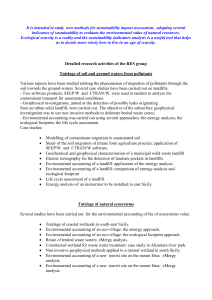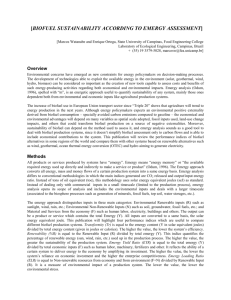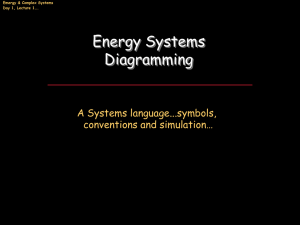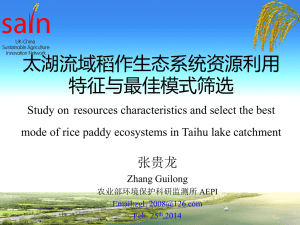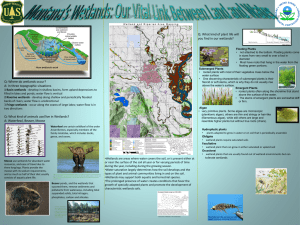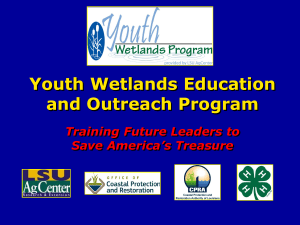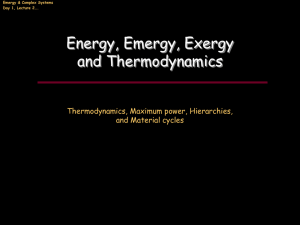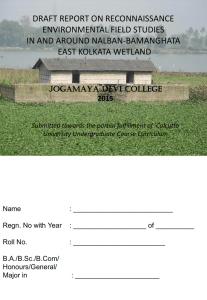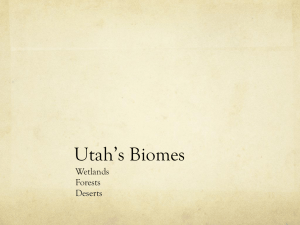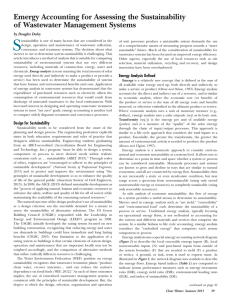PowerPoint File, 11,19 MB - UN-Water Activity Information System!
advertisement
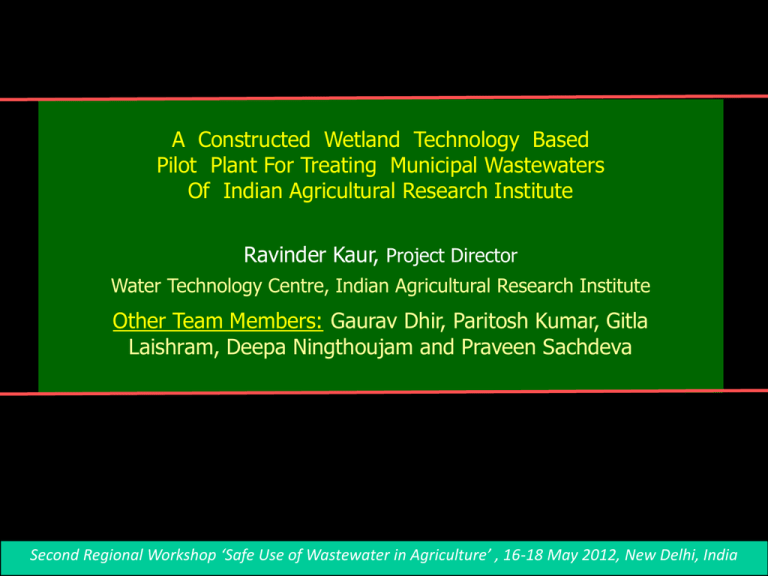
A Constructed Wetland Technology Based Pilot Plant For Treating Municipal Wastewaters Of Indian Agricultural Research Institute Ravinder Kaur, Project Director Water Technology Centre, Indian Agricultural Research Institute Other Team Members: Gaurav Dhir, Paritosh Kumar, Gitla Laishram, Deepa Ningthoujam and Praveen Sachdeva Second Regional Workshop ‘Safe Use of Wastewater in Agriculture’ , 16-18 May 2012, New Delhi, India NEED ASSESSMENT IARI Watershed (1030 ha) Total area- 466 ha Farm area- 290 ha Total irrigation Demand: 7.8 MLD Ground Water demand: 4.47 MLD (57 %) Canal Water Demand: 0.55 MLD (7 %) Deficit: 2.78 MLD Available Sewage: 22 MLD COSTLY UNSUSTAINABLE GENERATE HAZARDOUS SLUDGE CONSTRUCTED WETLANDS Experimental Wetland Site A PILOT PLANT FOR TREATING MUNICIPAL WASTEWATERS OF IARI 18 Experimental wetlands 3 wetland vegetations such as Reed grass (Phragmytis karka), Achorous calamus (Vacch) Typha latifolia (cattail) SW CW PW TW VW GW SW: Sewage Water CW: Non –Veg. Wetland water PW: Phragmites Water TW: Typha Water VW: Acorous (Vacch) Water GW: Ground Water SYSTEM LAYOUT Sewage Channel Main influent pipe Pump house Inlet Valve S u m p Influent pipe Control Screen Effluent pipe Outlet Valve Main effluent pipe SYSTEM MONITORING Influent pH EC TDS DO ORP Temperature Salinity Turbidity Carbonate & Waste Bicarbonate water Ca & Mg Na K ClFSO4-2 NO3- Plant PO -3 4 Soil Organic CarbonTreated Soil waterHeavy Metals Soil moisture content Effluent (Zn, Cu, Cd, Cr, Co, Mn, Fe, Ni, Pb) VOLUMETRIC EFFICIENCY 100 Percentage 80 60 81.8 98.4 80.1 78.48 40 20 0 Typha Phragmites Acorus Treatments Unplanted HYDRAULIC RETENTION TIME HRT (Hours) 60 50 40 Less than 1 day 30 20 10 0 Typha Phragmites Acorus Wetland Systems Unplanted POLLUTANT MASS REDUCTION EFFICIENCY 350 250 100.8 % 86% Percent 150 57% 68% 40% 53% 50 -50 Redox Potential Turbidity Nitrate Phosphate Potassium Sulphate -150 -250 Typha (T1) Phragmites (T2) Acorus (T3) Unplanted (T4) METAL MASS REDUCTION EFFICIENCY 90 39 % 50 % 44 % 70 50 30 Percent 10 -10 -30 IRON Typha (T1) NICKEL Phragmites (T2) Acorus (T3) COBALT Unplanted (T4) 60 50 40 43 % 17 % 30 20 10 0 Chromium Lead IMPACT OF TREATED & UNTREATED SEWAGE WATERS ON FOOD GRAIN CONTAMINATION IN WHEAT & PADDY 90 80 Metal Concentration (ppm) Wheat var. HD 2329 70 60 50 80.21 Food grain contamination in Wheat 73.95 -59% -54% MAL - 1 ppm MAL - 0.8 ppm 40 30 20 10 0 Pb Paddy var. Pusa Basmati 4 Metal Concentration (ppm) 140 120 100 80 Food grain contamination in Paddy Cr 125.88 120.85 MAL - 1 ppm -60% MAL - 1 ppm 60 40 -84% 28.99 21.61 20 0 Pb Cr The impact of the untreated and treated sewage water irrigations on the quality of produce from wheat and paddy fields was also assessed to show significantly (2-3 times) lower metal concentrations in the food grains produced from wetland treated sewage waters. TEMPORAL PROFILE OF SOIL METAL CONCENTRATIONS at SEWAGE PLOT SITE EMERGY BUDGET: Experimental Wetland Vs. Conventional STP Inputs Local renewable resources Solar Emergy (sej/yr) Experimental Wetlands Conventional STP 1.14 X 1016 1.82 X 1016 Purchased renewable Conventional STP had 143.27 times X 1015 resources More Resource Use than Purchased non renewable 3.97 X 1016 resources Experimental Wetlands 0.00 7.68 X 1017 Purchased resources 4.30 X 1016 7.68 X 1017 Total resource use 5.44 X 5.44 X 10 101616 17 7.87 X 10 7.87 1017 Emergy Based Sustainability Indices Emergy Yield Ratio (EYR) EYR = Y/F Y: Emergy yield ; F: Purchased emergy Environmental Load Ratio (ELR) ELR= (F + N) / R N: Non renewable resource emergy R: Local Renewable resource emergy Emergy Sustainability Index (ESI) ESI = EYR/ELR Percent Renewable Index (PR) PR = (R + Fr)/U Fr : Purchased renewable resource emergy U: Total resource use emergy Emergy Analysis of Experimental Wetland Vs. Conventional STP Emergy Indices Experimental Wetland Conventional Treatment Plant Environment Load Ratio 1.37 42.19 Emergy Yield Ratio 0.70 0.01 Experimental Wetlands exerts 33 times lesser Stress on STP RenewableEnvironment Percentage than Conventional 0.51 0.02 Experimental Wetlands were 70 times more Efficient in utilizing Emergy Sustainability 0.54 0.00034 purchased resources Index & Consumed 25 times more Renewable resources than Conventional STP Experimental Wetlands 1500 times more Sustainable than Conventional STP Salient Findings Overall Volumetric Efficiency of Experimental Wetland System: 84% Seasonal Nutrient & Metal Removal Efficiencies: 40 to 90% Planted Wetlands Performed Better than the Unplanted ones Typha Out-performed Phragmites and Acorus Wetlands: Smaller Ecological Footprint & OPEX, as consumed 100 times lesser non-renewable energy than STP Wetland based Wastewater treatment cost ½ of STP Eco-friendly Technology for Mitigating Global Environmental Pollution & Health Problems due to Improper Sewage Treatment Attractive Solution for Developing Countries with Scarce Resources for Investment in Expensive Centralized Sewage Infrastructure Outcome Technology Being Up-scaled for Treating Krishi Kunj Sewage Water & Augmenting IARI Irrigation Water Supplies Thank you
